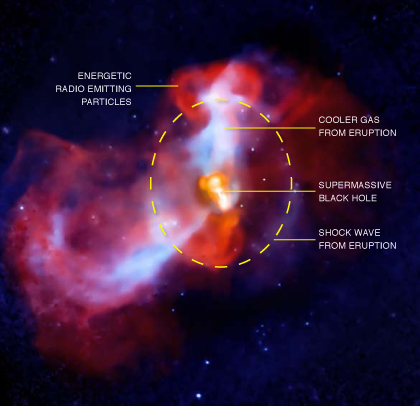Skip to comments.
M87:
Galactic Super-volcano in Action
chandra.harvard.edu ^
| August 18, 2010
Posted on 09/05/2010 10:46:55 AM PDT by Ernest_at_the_Beach
A galactic "super-volcano" in the massive galaxy M87 is erupting and blasting gas outwards, as witnessed by NASA's Chandra X-ray Observatory and NSF's Very Large Array. The cosmic volcano is being driven by a giant black hole in the galaxy's center and preventing hundreds of millions of new stars from forming.
Astronomers studying this black hole and its effects have been struck by the remarkable similarities between it and a volcano in Iceland that made headlines earlier this year.
At a distance of about 50 million light years, M87 is relatively close to Earth and lies at the center of the Virgo cluster, which contains thousands of galaxies. M87's location, coupled with long observations over Chandra's lifetime, has made it an excellent subject for investigations of how a massive black hole impacts its environment.
"Our results show in great detail that supermassive black holes have a surprisingly good control over the evolution of the galaxies in which they live," said Norbert Werner of the Kavli Institute for Particle Astrophysics and Cosmology at Stanford University and the SLAC National Accelerator Laboratory, who led one of two papers describing the study. "And it doesn't stop there. The black hole's reach extends ever farther into the entire cluster, similar to how one small volcano can affect practically an entire hemisphere on Earth."
The cluster surrounding M87 is filled with hot gas glowing in X-ray light, which is detected by Chandra. As this gas cools, it can fall toward the galaxy's center where it should continue to cool even faster and form new stars.
However, radio observations with the Very Large Array suggest that in M87 jets of very energetic particles produced by the black hole interrupt this process. These jets lift up the relatively cool gas near the center of the galaxy and produce shock waves in the galaxy's atmosphere because of their supersonic speed.
The scientists involved in this research have found the interaction of this cosmic "eruption" with the galaxy's environment to be very similar to that of the Eyjafjallajokull volcano, which forced much of Europe to close its airports earlier this year.
With Eyjafjallajokull, pockets of hot gas blasted through the surface of the lava, generating shock waves that can be seen passing through the grey smoke of the volcano. The hot gas then rises up in the atmosphere, dragging the dark ash with it. This process can be seen in a movie of the Eyjafjallajokull volcano where the shock waves propagating in the smoke are followed by the rise of dark ash clouds into the atmosphere.
In the analogy with Eyjafjallajokull, the energetic particles produced in the vicinity of the black hole rise through the X-ray emitting atmosphere of the cluster, lifting up the coolest gas near the center of M87 in their wake, much like the hot volcanic gases drag up the clouds of dark ash. And just like the volcano here on Earth, shockwaves can be seen when the black hole pumps energetic particles into the cluster gas.
"This analogy shows that even though astronomical phenomena can occur in exotic settings and over vast scales, the physics can be very similar to events on Earth," said co-author Aurora Simionescu also of the Kavli Institute.
In M87, the plumes of cooler gas being lifted upwards contain as much mass as all of the gas contained within 12,000 light years of the center of the galaxy cluster. This shows the black hole-powered volcano is very efficient at blasting the galaxy free of the gas that would otherwise cool and form stars.
"This gas could have formed hundreds of millions of stars if the black hole had not removed it from the center of the galaxy. That seems like a much worse disruption than what the airline companies on Earth had to put up with earlier this year," said Evan Million, a graduate student at Stanford University and lead-author of the other paper to be published about this deep study of M87.
The eruption in M87 that lifted up the cooler gas must have occurred about 150 million years earlier, but a smaller eruption only about 11 million years earlier produced the shock wave. The Chandra image was based on an observation lasting almost 7 days. X-ray data from ESA's XMM-Newton was also used in this study.
The two papers describing these results will appear in the journal of the Monthly Notices of the Royal Astronomical Society. NASA's Marshall Space Flight Center in Huntsville, Ala., manages the Chandra program for NASA's Science Mission Directorate in Washington. The SmithsonianAstrophysical Observatory controls Chandra's science and flight operations from Cambridge, Mass.
More information, including images and other multimedia, can be found at:http://chandra.harvard.edu and http://chandra.nasa.gov
TOPICS: Astronomy; Science
KEYWORDS: blackhole; catastrophism; m87; stringtheory; xplanets
Image at the Chandra Website.
To: Ernest_at_the_Beach
From :
Galactic Super-volcano in Action
******************************EXCERPT********************************
In the analogy with Eyjafjallajokull, the energetic particles produced in the vicinity of the black hole rise through the X-ray emitting atmosphere of the cluster, lifting up the coolest gas near the center of M87 in their wake. This is similar to the hot volcanic gases that drag up the clouds of dark ash. And just like the volcano here on Earth, shock waves can be seen when the black hole pumps energetic particles into the cluster gas. The energetic particles, coolest gas and shock waves are shown in a labeled version.
To: Ernest_at_the_Beach
It's pronounced ˈɛɪjaˌfjatl̥aˌjœkʏtl̥, of course
3
posted on
09/05/2010 10:52:55 AM PDT
by
Teacher317
(remember dismember November)
To: Ernest_at_the_Beach
Warch out for them ‘energetic particles’.. they’ll mess up a paint job real quick.. ;-)
4
posted on
09/05/2010 10:58:44 AM PDT
by
NormsRevenge
(Semper Fi ... Godspeed .. Monthly Donor Onboard .. Obama: Epic Fail or Bust!!!)
To: LibWhacker; SunkenCiv
To: Teacher317
Just when I thought I no longer had to worry about how to spell Eyjafjallajokull, this comes along.
If the galaxy is 50 million light-years away, that means the event actually happened 50 million years ago. In other words, this is not Bush's fault.
But count on the MSM to blame him for it anyway...if only he had accepted the Kyoto Protocols.
To: NormsRevenge; Teacher317
To: Ernest_at_the_Beach
Putting out maybe, JUST enough energy to power carbon hog, Al Gore’s guest house annex.
8
posted on
09/05/2010 11:24:15 AM PDT
by
EyeGuy
To: Ernest_at_the_Beach
Old News. I mean 50 million years ago??!??
(It must be the irony.)
9
posted on
09/05/2010 11:28:56 AM PDT
by
Delta 21
(If you cant tell if I'm being sarcastic...maybe I'm not.)
To: Ernest_at_the_Beach
a giant black hole in the galaxy's centerDoes that mean it's softball sized?
10
posted on
09/05/2010 11:29:36 AM PDT
by
fso301
To: fso301
From here it is hard to tell....and I don’t want to get closer.
To: Teacher317
It's pronounced ˈɛɪjaˌfjatl̥aˌjœkʏtl̥, of course
12
posted on
09/05/2010 1:07:19 PM PDT
by
JRios1968
(The real first rule of Fight Club: don't invite Chuck Norris...EVER)
To: Ernest_at_the_Beach
Thanks. Mind. Is. Blown. Happens to me several times a week as I try to keep up with all the latest astro news. There is no end to it. It truly seems like the universe is so mind blowingly enormous and complex, that it can blow your mind every day of the week for decades on end, with a different new mind blowing fact every day, and still have an infinite number of mind blowing facts up its sleeve to throw at you. How can that be if an infinite God didn't make it so?
Well... That thought just occurred to me, so I thought I'd put it out there.
13
posted on
09/05/2010 8:22:50 PM PDT
by
LibWhacker
(America awake!)
To: Ernest_at_the_Beach; 75thOVI; aimhigh; Alice in Wonderland; AndrewC; aragorn; aristotleman; ...
Thanks Ernest_at_the_Beach, it's a freeping three-ping!
M87 site:freerepublic.com
Google
14
posted on
09/06/2010 5:04:05 PM PDT
by
SunkenCiv
(Democratic Underground... matters are worse, as their latest fund drive has come up short...)
To: AdmSmith; bvw; callisto; ckilmer; dandelion; ganeshpuri89; gobucks; KevinDavis; Las Vegas Dave; ...
15
posted on
09/06/2010 5:08:39 PM PDT
by
SunkenCiv
(Democratic Underground... matters are worse, as their latest fund drive has come up short...)
To: KevinDavis; annie laurie; garbageseeker; Knitting A Conundrum; Viking2002; Mmogamer; ...
Thanks Ernest_at_the_Beach.
16
posted on
09/06/2010 5:08:42 PM PDT
by
SunkenCiv
(Democratic Underground... matters are worse, as their latest fund drive has come up short...)
To: Ernest_at_the_Beach
....Keep in mind. We are just now seeing this, and it happened 57 million years ago.
17
posted on
09/06/2010 5:09:18 PM PDT
by
KoRn
(Department of Homeland Security, Certified - "Right Wing Extremist")
To: NormsRevenge
And I just washed the Jeep too!
18
posted on
09/06/2010 5:16:55 PM PDT
by
Eaker
(Pablo is very wily)
Disclaimer:
Opinions posted on Free Republic are those of the individual
posters and do not necessarily represent the opinion of Free Republic or its
management. All materials posted herein are protected by copyright law and the
exemption for fair use of copyrighted works.
FreeRepublic.com is powered by software copyright 2000-2008 John Robinson




